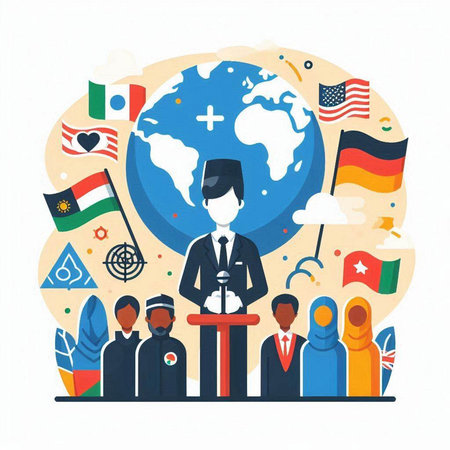Understanding Diversity and Inclusion in U.S. Workplaces
Diversity and inclusion have become fundamental values for American teams striving to achieve high performance, innovation, and long-term success. In the U.S., diversity goes beyond visible traits like race, gender, or age; it encompasses varied perspectives, backgrounds, abilities, cultures, and even ways of thinking. Inclusion means creating an environment where all individuals feel valued, respected, and empowered to contribute their unique strengths. Embracing these principles helps organizations tap into a broader range of ideas and experiences—fueling creativity and problem-solving. For American workplaces, fostering diversity and inclusion isn’t just about fulfilling legal or ethical obligations; it’s a strategic advantage that drives productivity, attracts top talent, and helps teams better serve diverse markets. As teams become increasingly multicultural and multifaceted, understanding these concepts is essential for building trust, collaboration, and resilience in the face of conflict.
Common Causes of Conflict in Multicultural Teams
Multicultural teams are a dynamic blend of backgrounds, ideas, and perspectives—but this diversity can also be a source of friction if not managed proactively. Understanding the most frequent causes of conflict is the first step toward building trust and collaboration. Here’s an overview of common points of tension that often arise in diverse and inclusive workplaces:
| Cultural Difference | Potential Conflict Trigger |
|---|---|
| Communication Styles | Direct vs. indirect communication; misunderstandings due to tone or non-verbal cues. |
| Approach to Hierarchy | Some cultures value flat structures, while others expect clear authority lines, leading to confusion over decision-making. |
| Attitudes Toward Time | Differing views on punctuality and deadlines may cause frustration or perceptions of disrespect. |
| Feedback Preferences | Varied comfort levels with public vs. private feedback, and how criticism is expressed or received. |
| Local Workplace Norms | Different expectations around work-life balance, holidays, and professional boundaries. |
Communication Gaps
Language barriers, idioms, and jargon can easily lead to misinterpretations. Team members may avoid speaking up for fear of being misunderstood or offending others, resulting in silos and diminished innovation.
Expectations Around Collaboration
Cultural background shapes how people view teamwork versus individual achievement. This can lead to clashes over recognition, workload sharing, and what constitutes successful collaboration.
The Role of Unconscious Bias
Even the most inclusive environments are not immune to unconscious bias. Preconceived notions about competence, leadership style, or communication ability can quietly influence interactions and fuel conflict if not addressed openly.
Navigating Local Legal & Ethical Standards
Diverse teams often span multiple geographies where labor laws and ethical norms differ. What’s acceptable or expected in one location may be at odds with another, requiring clear guidelines for alignment.

3. Culturally-Sensitive Communication Techniques
Open and respectful communication is the backbone of effective conflict management, especially in diverse and inclusive teams. Navigating conversations across various backgrounds, beliefs, and communication styles requires both intention and skill. Here are some practical tips for fostering culturally-sensitive discussions:
Encourage Active Listening
Give everyone the chance to speak without interruption. Summarize what you’ve heard to confirm understanding before responding. This shows respect for different perspectives and reduces miscommunication.
Be Mindful of Nonverbal Cues
Body language, eye contact, and tone can vary widely between cultures. What seems natural to one person may feel uncomfortable or disrespectful to another. When in doubt, ask team members how they prefer to communicate or observe their comfort levels during interactions.
Avoid Assumptions and Stereotypes
Don’t assume that everyone shares your background or communication preferences. Instead, approach every conversation with curiosity and an open mind. Avoid generalizations and focus on individual experiences and needs.
Adapt Your Communication Style
If a team member prefers direct feedback while another values more indirect approaches, try to meet each style halfway. Use clear, simple language, check for understanding, and remain flexible as you navigate group dynamics.
Create Safe Spaces for Dialogue
Encourage questions and honest dialogue without fear of judgment. Let your team know that it’s okay to clarify intent or ask about cultural references they don’t understand. Building this trust lays the groundwork for open, productive discussions where everyone feels included.
4. Customizing Conflict Resolution Approaches
When managing conflicts in diverse and inclusive teams, there’s no one-size-fits-all solution. Every team member brings unique perspectives shaped by their personality, cultural background, and work style. Tailoring your approach not only empowers individuals but also strengthens the collaborative spirit within your team. Here are practical strategies for customizing conflict resolution methods:
Understanding Different Personality Types
| Personality Type | Preferred Approach | Tips for Leaders |
|---|---|---|
| Assertive | Direct communication, focus on outcomes | Encourage constructive debate, set clear expectations |
| Amiable | Collaborative discussion, seek consensus | Foster open dialogue, validate feelings |
| Analytical | Fact-based solutions, structured process | Provide data, clarify decision-making steps |
| Expressive | Brainstorming, creative problem-solving | Create space for ideas, recognize contributions |
Adapting to Cultural Backgrounds and Communication Styles
- Acknowledge Differences: Encourage team members to share their preferred communication styles or conflict resolution traditions at the outset of projects.
- Cultural Sensitivity: Be mindful of direct vs. indirect communication preferences; adapt your language and tone accordingly.
Situational Strategies for Collaborative Resolution
- If a disagreement is about deadlines, use a structured mediation session with clear timelines and responsibilities.
- If the conflict is rooted in miscommunication, hold a roundtable where each member paraphrases the other’s point of view before responding.
Empowering Team Members to Take Initiative
Create opportunities for peer-led conflict resolution training and support systems such as buddy programs or rotating facilitators. Encourage feedback loops so that everyone can learn from each experience and continuously improve how they navigate disagreements together. Remember: when team members feel equipped and trusted to handle conflict collaboratively, it leads to more resilient and innovative teams.
5. Fostering Psychological Safety and Team Trust
Building psychological safety is a cornerstone for diverse and inclusive teams to effectively manage conflict and unlock their full potential. When teammates feel safe to express ideas, ask questions, and share concerns without the risk of embarrassment or retaliation, it paves the way for innovation and genuine collaboration. Leaders play a pivotal role in setting the tone for trust, but every team member can contribute to a safe environment.
Lead by Example
Leaders should model vulnerability by openly sharing their own uncertainties and learning from mistakes. Admitting when you don’t know something or acknowledging your missteps shows that it’s okay to be human at work. This transparency builds trust and encourages others to bring their authentic selves to the table.
Establish Inclusive Communication Norms
Create clear ground rules for respectful dialogue, such as not interrupting, actively listening, and giving everyone an opportunity to speak. Use inclusive language and check for understanding across cultural lines. Encourage teammates to call out microaggressions or bias in a constructive way, making it clear that everyone’s voice matters.
Encourage Open Feedback Loops
Implement regular feedback practices—like retrospectives or one-on-one check-ins—where team members can safely discuss what’s working and what isn’t. Anonymous surveys can also provide space for quieter voices to surface concerns. Make sure feedback is seen as a tool for growth rather than criticism.
Celebrate Diverse Perspectives
Acknowledge and appreciate different viewpoints by publicly recognizing contributions from all backgrounds. Highlight how varied perspectives drive better problem-solving and creativity. This recognition reinforces psychological safety by showing that diversity is valued, not just tolerated.
Respond Supportively to Conflict
When conflicts arise, approach them with empathy and curiosity rather than judgment. Encourage solutions-focused discussions where the goal is mutual understanding instead of assigning blame. By responding supportively, leaders and teammates reinforce that it’s safe to raise difficult topics and that the team will navigate challenges together.
By intentionally fostering psychological safety and trust, diverse teams create the foundation needed to address conflict constructively—and turn differences into strengths.
6. Encouraging Ongoing Learning and Inclusive Growth
Building a truly diverse and inclusive team is an evolving journey that thrives on continuous improvement and learning. To keep your team moving forward, it’s essential to adopt strategies that promote ongoing education, open feedback, and a culture of growth for everyone.
Foster a Culture of Lifelong Learning
Encourage team members to pursue professional development through regular workshops, webinars, or online courses focused on both conflict management and diversity topics. Partner with organizations that specialize in DEI (Diversity, Equity, and Inclusion) to provide fresh perspectives and up-to-date best practices. Make learning accessible by offering flexible formats and supporting different learning styles.
Create Safe Spaces for Honest Feedback
Establish regular check-ins and feedback loops—such as anonymous surveys or open-door policies—that allow team members to share experiences without fear of retaliation. Normalize constructive criticism by framing feedback as an opportunity for growth, not blame. Consider rotating facilitators or inviting external moderators to ensure everyone feels heard.
Celebrate Progress and Reflect Together
Take time to acknowledge milestones—no matter how small—in your team’s journey toward greater inclusion and effective conflict resolution. Host periodic retrospectives where you reflect on what’s working and identify areas for further improvement. Recognize individuals who model inclusive behaviors and encourage peer-to-peer appreciation.
Leverage Mentorship and Peer Support
Pair new hires or underrepresented team members with mentors who can provide guidance in navigating workplace dynamics. Encourage cross-team collaborations and buddy systems to build trust across different backgrounds. These relationships help break down silos and empower individuals to grow together.
Stay Agile and Open to Change
The needs of diverse teams will evolve over time. Stay responsive by regularly revisiting your conflict management processes and DEI initiatives. Solicit input from all levels of the organization, experiment with new approaches, and be willing to adapt when something isn’t working. Remember: inclusion is a practice—not just a policy.
By prioritizing continuous education, fostering honest communication, celebrating wins, promoting mentorship, and staying agile, you’ll create an environment where every team member feels valued—and where everyone can contribute to resolving conflicts constructively while growing together.

